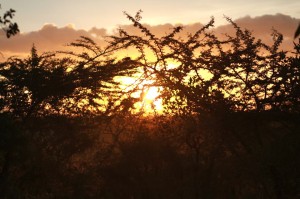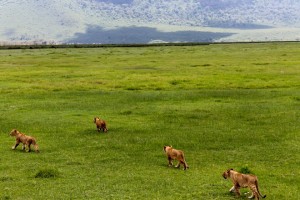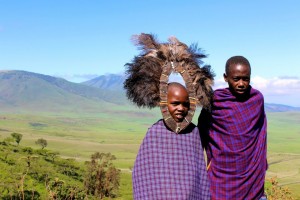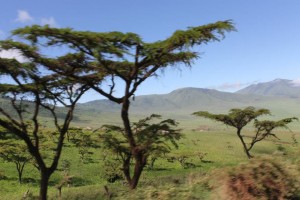Less than 20 yards away from where the viewers’ Safari vehicles were parked, two female lions set off in nearly opposite directions, one following a rounded trajectory to the left and the other headed right.

The sun casts the last of the day’s golden rays as it sets on the campgrounds bordering the Ngorongoro Crater (Photo by Cody Emberton).
Their movements were deliberately slow, true to the coldly calculating predators they are. Periodically, they dropped down to their haunches, eye-level with the grass around them; blending into the scenery.
In the distance, a herd of zebras grazed casually, unaware of the approaching hunters. Their tails flicked from side to side, lazily swatting the persistent African flies from their muscled, black-and-white striped bodies.
A muffled gasp rippled through the crowd as, in a domino effect, the onlookers discovered the presence of a third female lion stationed directly opposite and in between the two nearest them. She, too, took measured strides forward, interrupted regularly by lengthy, camouflaged pauses. They worked as a team, patiently circling their prey.
Back by the safari vans, two male lions lounged and seven lion cubs wrestled in the grass, occasionally crossing the dirt road to boldly inspect the vehicles and people intruding on their habitat. If you had the mind and the guts to do so, you could reach your hand out to touch them.
The males perked their heads up as they became aware of the hunt and impending kill. They rose to a sitting position to join the tourists in watching the show.
Somehow, imperceptibly, one of the zebras sensed their pursuers and alerted the others in the herd. All of a sudden, in a cloud of dust they took off running, not stopping until they reached safety as specks at the farthest edge of our line of vision.

Several lion cubs romp around in the open plains of Tanzania’s Ngorongoro Crater (Photo by Cody Emberton).
The females came together and the males and cubs rejoined them now about 100 yards from where they had started. They resumed all prior activities—males and females dozing off in the sun, while their cubs romped around in the grass.
While the lions seemed unfazed by their failed attempt at a kill, the people back at the vans erupted in animated discussions of the scene they had just witnessed.
“Did you see that?!” the visitors repeated over and over again.
The Safari guides called out to one another in greeting and laughed, amused by the tourists’ shocked reactions. This was just another day in the Ngorongoro Crater—the largest non-flooded caldera in the world.
For one tourist, a self-taught professional photographer from Tennessee, it was the baby zebras, not the lions that stole the show that day.
“I have never been so captivated,” said Cody Emberton, 26. “Seeing a baby zebra literally took my breath away!”
According to Emberton, it wasn’t just the safari that made the trip an experience of a lifetime. She traveled with a tourist company called Pristine Trails Adventures and Safaris that offers a variety of camp-style lodgings to its customers.
“My favorite part of the trip was the first night,” Emberton said. “ We had a pretty good dinner, but the extra helpings of laughter made it memorable. There was a cluster of people from all over the U.S., Africa, even Norway just sitting around a campfire sharing stories and Konyagi (Tanzanian gin). And then the stars and handfuls of comets in the African sky. I have never seen so many stars in all of my life!”

Co-inhabitants with the wildlife, two indigenous Maasai children stand poised at the edge of the Ngorongoro Crater (Photo by Samantha Lucci).
One of the most popular tourist destinations in the world, the Ngorongoro Crater boasts thousands of visitors each year. It is part of the Ngorongoro Conservation Area, which covers more than 8,200 square kilometers of land in the Arusha Region of Tanzania.
The natural world wonder has been designated a multiple land use area used to promote the conservation of natural resources, tourism and to protect the interest of indigenous residents; namely members of the Maasai tribes who cohabitate the Crater and raise cattle within the its domain.
If you ask Emberton, a visit to Ngorongoro is “something to make sure you experience. I only wish I could have stayed longer.”
If You Go
How to Get There:
- Reaching Tanzania by air: Fly to Kilimanjaro International Airport in Moshi, situated near the foot of Mount Kilimanjaro.
- Reaching the Crater by road: Several tourist companies in Moshi offer weekend trips to the Ngorongoro Crater, and package deals that include Serengeti National Park as well.
- Pristine Trails Adventures and Safaris, Phone: +255 (0) 27 2754463, Mobile: +255 717 100788, +255 715 678393. E-mail: info@pristinetrails.com, http://www.pristinetrails.com/.
When to Visit
- According to the Ngorongoro Crater’s main webpage there are two main seasons that are best to visit the Crater:
- The Rainy Season: November to April; Short rains: November to December. Long rains: February to April (considered the off-season). Significance: animal congregate on the Short Grass Plains to give birth, and migration occurs on the plains from February to March, attracting large numbers of predators
- The Dry Season: May to October. Significance: animals congregate along permanent water sources, making this season ideal for game viewing (except for the Short Grass Plains, which become devoid of game)
- Safaris can cost upwards of the Tanzanian equivalent of $400 per person.
- For more information on the Ngorongoro Crater, the available lodgings and the sites and people to see visit the Ngorongoro Conservation Area website at: http://www.ngorongorocrater.org/index.html.

